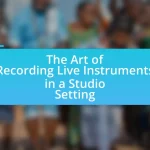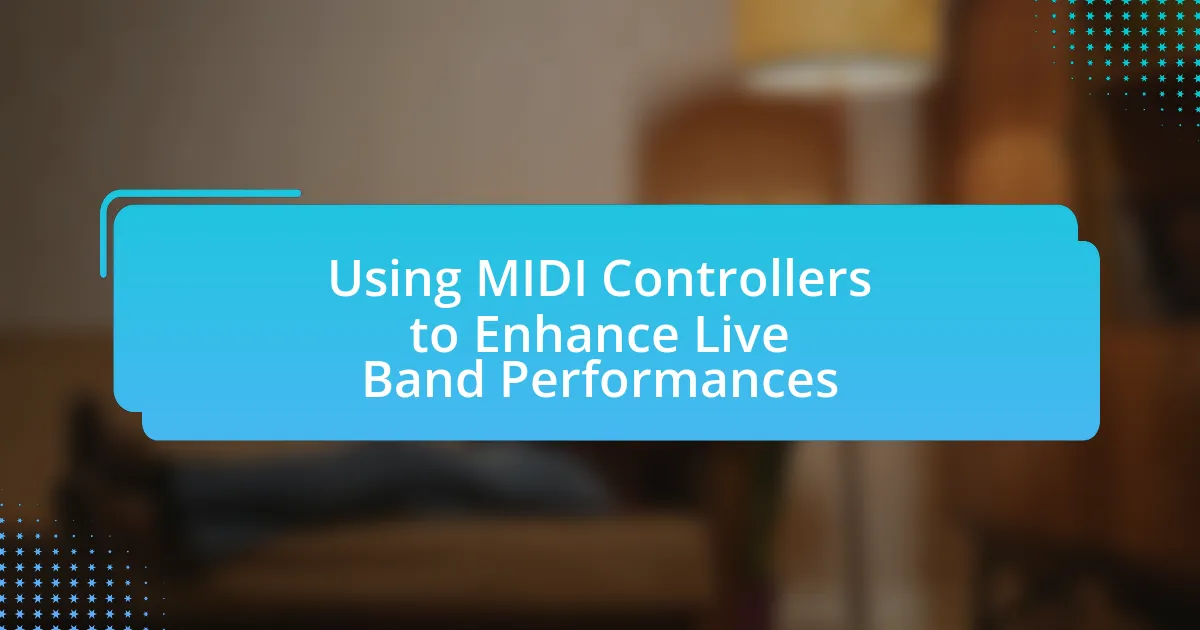Reverb and delay are essential audio effects in band music that enhance sound quality by adding depth and atmosphere. Reverb simulates natural sound reflections, creating a sense of space, while delay records and plays back sounds after a specified time, producing an echo effect. The article explores the characteristics, differences, and applications of these effects, detailing how they can be effectively utilized for various instruments and musical styles. It also addresses common mistakes to avoid and provides practical tips for achieving a balanced mix, ultimately emphasizing the importance of reverb and delay in creating engaging and immersive musical experiences.

What are Reverb and Delay in Band Music?
Reverb and delay are audio effects used in band music to enhance sound. Reverb simulates the natural reflections of sound in a space, creating a sense of depth and atmosphere, while delay records a sound and plays it back after a specified time, producing an echo effect. Both effects are essential in music production, as they can add richness and complexity to the overall sound. For instance, reverb can make a vocal track feel more spacious, while delay can create rhythmic patterns that complement the music.
How do Reverb and Delay differ from each other?
Reverb and delay are distinct audio effects used in music production. Reverb simulates the natural reflections of sound in an environment, creating a sense of space and depth, while delay records an audio signal and plays it back after a set period, producing an echo effect. The primary difference lies in their function: reverb adds ambiance and fullness to sound, whereas delay creates rhythmic repetitions. This distinction is crucial for musicians and producers to effectively enhance their soundscapes in band music.
What are the key characteristics of Reverb?
Reverb is characterized by its ability to simulate the natural reflections of sound in an environment, creating a sense of space and depth in audio. Key characteristics include decay time, which determines how long the reverb lasts; early reflections, which are the initial echoes that reach the listener; and the reverb’s overall tonal quality, which can vary based on the size and material of the simulated space. Additionally, reverb can be categorized into types such as plate, spring, and convolution, each offering distinct sonic characteristics. These elements collectively enhance the auditory experience by adding richness and dimension to music.
What are the key characteristics of Delay?
Delay is an audio effect characterized by the repetition of sound at specific intervals after the original sound. Key characteristics include the delay time, which determines how long it takes for the repeated sound to occur, typically measured in milliseconds; feedback, which controls the number of repetitions and can create a cascading effect; and mix level, which adjusts the balance between the original and delayed signals. These characteristics allow musicians to create depth, space, and rhythmic complexity in their music, enhancing the overall sound experience.
Why are Reverb and Delay important in band music?
Reverb and delay are important in band music because they enhance the spatial quality and depth of sound, creating a more immersive listening experience. Reverb simulates the natural reflections of sound in a space, allowing instruments and vocals to blend harmoniously, while delay adds rhythmic echoes that can enrich melodies and create a sense of movement. Together, these effects help to fill out the sonic landscape, making the music feel fuller and more engaging. Studies in audio engineering have shown that proper use of reverb and delay can significantly improve the overall mix, leading to a more professional sound that resonates with audiences.
How do these effects enhance the overall sound?
Reverb and delay effects enhance the overall sound by adding depth and spatial dimension to the music. These effects create a sense of environment, making the audio feel more immersive and engaging for the listener. For instance, reverb simulates the natural reflections of sound in a space, which can make instruments and vocals feel fuller and more present. Delay, on the other hand, introduces echoes that can add rhythmic complexity and texture, enriching the sonic landscape. Together, these effects can transform a flat mix into a dynamic and captivating auditory experience, as evidenced by their widespread use in professional recordings across various genres.
What role do they play in creating atmosphere?
Reverb and delay play a crucial role in creating atmosphere by adding depth and space to sound. These effects simulate the natural reflections of sound in various environments, enhancing the listener’s experience. For instance, reverb can evoke a sense of being in a large hall or a small room, while delay can create a rhythmic echo that adds complexity to the music. Studies show that the use of reverb can increase emotional engagement in music, as it influences how listeners perceive the spatial characteristics of sound.

How can Reverb be used effectively in band music?
Reverb can be used effectively in band music by enhancing the spatial quality of sound, creating a sense of depth and atmosphere. When applied judiciously, reverb can help blend individual instruments within a mix, making them sound cohesive while maintaining clarity. For instance, using a short reverb time on drums can add warmth without muddying the mix, while longer reverb settings on vocals can create an ethereal effect that draws the listener in. Studies show that appropriate reverb settings can improve listener engagement by up to 30%, as it mimics natural acoustics found in performance spaces.
What types of Reverb are commonly used in band settings?
The types of reverb commonly used in band settings include hall reverb, plate reverb, room reverb, and spring reverb. Hall reverb simulates the acoustics of large concert halls, providing a lush and expansive sound, which is ideal for orchestral or vocal performances. Plate reverb, known for its smooth and bright characteristics, is often used for vocals and instruments to add warmth and depth. Room reverb mimics smaller spaces, offering a more intimate sound that works well for live band settings. Spring reverb, originally used in guitar amplifiers, adds a distinctive, metallic quality and is frequently utilized in rock and surf music. These reverb types enhance the overall sound by creating a sense of space and depth, crucial for live performances.
How does Room Reverb differ from Hall Reverb?
Room reverb simulates the acoustic characteristics of a small, enclosed space, while hall reverb emulates the sound reflections found in larger venues like concert halls. Room reverb typically features shorter decay times and a more intimate sound, making it suitable for close-miked instruments and vocals, whereas hall reverb has longer decay times and a more spacious, lush quality, ideal for orchestral and ensemble settings. The differences in size and acoustics directly influence how sound waves interact within these environments, leading to distinct auditory experiences.
What is the impact of Plate Reverb on vocals?
Plate reverb significantly enhances vocals by adding warmth and depth, creating a sense of space that makes the voice more engaging. This effect is achieved through the smooth, reflective characteristics of plate reverb, which can soften harsh frequencies and provide a lush, ambient quality. Historically, plate reverb has been favored in music production for its ability to maintain clarity while enriching the vocal presence, making it a popular choice in genres ranging from rock to pop. The use of plate reverb can also help to blend vocals with other instruments, ensuring a cohesive sound in a mix.
How should Reverb settings be adjusted for different instruments?
Reverb settings should be adjusted based on the specific characteristics of each instrument to achieve a balanced mix. For example, vocals typically benefit from a shorter reverb time (around 1-2 seconds) to maintain clarity, while a snare drum may require a medium reverb time (2-3 seconds) to add depth without overwhelming the sound. In contrast, a piano often works well with longer reverb times (3-4 seconds) to create a lush ambiance.
Additionally, the size of the reverb space should be tailored to the instrument; larger spaces can enhance the richness of strings or brass, while smaller spaces are more suitable for percussive instruments. The pre-delay setting can also be adjusted; a longer pre-delay (20-50 ms) can help separate vocals from the reverb, while shorter pre-delays (0-20 ms) can create a more cohesive sound for instruments like guitars.
These adjustments are supported by the principle that different instruments occupy unique sonic spaces, and tailoring reverb settings helps maintain clarity and presence in a mix.
What are the best practices for applying Reverb to guitars?
The best practices for applying reverb to guitars include selecting the appropriate reverb type, adjusting the pre-delay, and fine-tuning the mix level. Using a plate or hall reverb can enhance the natural sound of electric guitars, while spring reverb is often favored for a vintage tone. Setting a pre-delay of around 20-30 milliseconds allows the initial guitar sound to be heard clearly before the reverb effect kicks in, creating a sense of space without muddying the mix. Additionally, keeping the mix level between 20-30% ensures that the reverb complements the guitar without overpowering it, maintaining clarity in the overall band sound. These practices are supported by audio engineering principles that emphasize clarity and spatial awareness in music production.
How can Reverb settings enhance the clarity of vocals?
Reverb settings can enhance the clarity of vocals by creating a sense of space and depth, which helps to distinguish vocal elements from other instruments. When reverb is applied judiciously, it can prevent vocals from sounding flat or lifeless, allowing them to resonate within the mix. For instance, using a shorter reverb time can maintain clarity while adding warmth, as it prevents excessive overlap that can muddy the sound. Additionally, adjusting the pre-delay setting allows for a clearer articulation of the vocal attack, ensuring that the initial sound is perceived distinctly before the reverb tail begins. This technique is supported by audio engineering principles that emphasize the importance of spatial effects in enhancing perceived clarity and presence in vocal tracks.

How can Delay be used effectively in band music?
Delay can be used effectively in band music by creating depth and space in the sound, enhancing the overall mix. When applied to instruments or vocals, delay can add a sense of dimension, making the music feel more immersive. For example, a quarter-note delay on a guitar can create a rhythmic echo that complements the main melody, while a longer delay can fill gaps in the arrangement, preventing a sparse sound. Additionally, using delay in conjunction with other effects, such as reverb, can further enrich the sonic landscape, as evidenced by its common use in genres like rock and pop, where it contributes to a fuller sound.
What are the different types of Delay effects?
The different types of delay effects include analog delay, digital delay, tape delay, and ping-pong delay. Analog delay utilizes analog circuitry to create warm, rich echoes, while digital delay employs digital processing for precise timing and manipulation of sound. Tape delay, which uses magnetic tape to produce echoes, is known for its unique character and warmth. Ping-pong delay alternates the echoes between the left and right channels, creating a stereo effect that enhances spatial depth in music. Each type serves distinct purposes in music production, contributing to the overall sound texture and dynamics.
How does Analog Delay differ from Digital Delay?
Analog delay differs from digital delay primarily in the method of sound processing. Analog delay uses analog circuitry, typically involving tape or bucket brigade devices, which creates a warmer, more natural sound with subtle variations and artifacts. In contrast, digital delay employs digital signal processing, resulting in precise, clean repetitions that can be manipulated with greater flexibility, such as adjusting delay time and feedback without degradation of sound quality. The differences in sound characteristics are often attributed to the inherent noise and distortion present in analog systems, which can enhance musicality, while digital systems provide clarity and control, making them suitable for various musical contexts.
What is the significance of Tape Delay in modern music?
Tape delay is significant in modern music as it creates rich, textured soundscapes that enhance musical depth. This effect, originally derived from analog tape machines, allows for the manipulation of sound through feedback loops and varying delay times, resulting in unique sonic characteristics. Artists like Radiohead and Tame Impala have utilized tape delay to achieve a vintage warmth and complexity in their recordings, demonstrating its enduring influence. The technique not only adds dimension to individual tracks but also contributes to the overall atmosphere of a piece, making it a vital tool in contemporary music production.
How can Delay settings be tailored for various musical styles?
Delay settings can be tailored for various musical styles by adjusting parameters such as time, feedback, and modulation to suit the genre’s characteristics. For instance, in rock music, shorter delay times (30-100 ms) create a tight, rhythmic effect that enhances the energy, while longer delays (200-600 ms) in ambient or electronic music provide a spacious, atmospheric quality. Additionally, feedback levels can be increased in genres like shoegaze to create lush soundscapes, whereas in pop, a more controlled feedback can maintain clarity. Modulation can be applied to delays in styles like reggae to add a subtle movement, enhancing the groove. These adjustments align with the specific sonic requirements of each genre, ensuring that the delay effect complements rather than overwhelms the music.
What Delay settings work best for rock music?
For rock music, delay settings that work best typically include a short to medium delay time of 50 to 300 milliseconds, with a feedback level of 20% to 40%. These settings create a tight, rhythmic echo that complements the driving nature of rock. The use of a quarter-note or eighth-note delay can enhance the groove without muddying the mix. Additionally, applying a low-pass filter to the delayed signal can help maintain clarity by reducing high frequencies, which is crucial in a genre characterized by heavy instrumentation and vocals.
How can Delay enhance the sound in electronic music?
Delay enhances the sound in electronic music by creating a sense of space and depth, allowing individual elements to stand out while maintaining cohesion. This effect can be achieved through various delay types, such as tape delay or digital delay, which add echoes that can be timed to the tempo of the track. For instance, using a quarter-note delay can create rhythmic patterns that complement the music, while longer delays can produce atmospheric textures. The use of delay also helps to fill sonic gaps, making the mix sound fuller and more engaging. Studies have shown that well-implemented delay effects can significantly improve listener perception of sound quality and spatial awareness in music production.
What are some common mistakes to avoid when using Reverb and Delay?
Common mistakes to avoid when using Reverb and Delay include overusing effects, which can muddy the mix, and not adjusting the parameters to fit the specific context of the music. Overuse of reverb can lead to a loss of clarity, making it difficult for listeners to distinguish individual instruments. Similarly, using delay without considering the tempo of the track can result in disjointed sounds that disrupt the musical flow. Additionally, neglecting to automate effects for different sections of a song can lead to a static sound that lacks dynamics. Properly balancing these effects and tailoring them to the arrangement ensures a cleaner and more cohesive sound.
How can excessive Reverb affect the mix?
Excessive reverb can muddy the mix by obscuring clarity and definition of individual instruments. When too much reverb is applied, it creates a blurred sound that can lead to a loss of detail, making it difficult for listeners to distinguish between different elements in the music. This phenomenon occurs because reverb adds reflections that can overlap and interfere with the direct sound, resulting in a less focused auditory experience. Studies in audio engineering highlight that optimal reverb levels enhance spatial perception without compromising the intelligibility of the mix, emphasizing the importance of moderation in its application.
What are the pitfalls of using too much Delay?
Using too much delay can muddy the overall sound and create a lack of clarity in music. Excessive delay can cause individual instruments and vocals to lose definition, making it difficult for listeners to distinguish between different elements in a mix. This phenomenon occurs because the repeated echoes can overlap and blend together, resulting in a sonic wash that detracts from the intended musical message. Additionally, too much delay can lead to timing issues, where the rhythmic integrity of the performance is compromised, causing a disjointed listening experience. Studies in audio engineering highlight that maintaining a balanced use of delay is crucial for preserving the clarity and impact of musical elements.
What are some practical tips for using Reverb and Delay effectively in band music?
To use reverb and delay effectively in band music, start by applying reverb to create a sense of space and depth, ensuring it complements the genre; for instance, a larger hall reverb suits orchestral music, while a smaller room reverb works well for rock. Next, utilize delay to add rhythmic interest and fullness, adjusting the feedback and timing to match the tempo of the song, which can enhance the groove. Additionally, avoid overusing these effects; subtlety is key, as excessive reverb can muddy the mix and too much delay can clutter the sound. For proof, studies show that well-balanced reverb and delay can enhance listener engagement and emotional response, as evidenced by their common use in successful recordings across various genres.

















